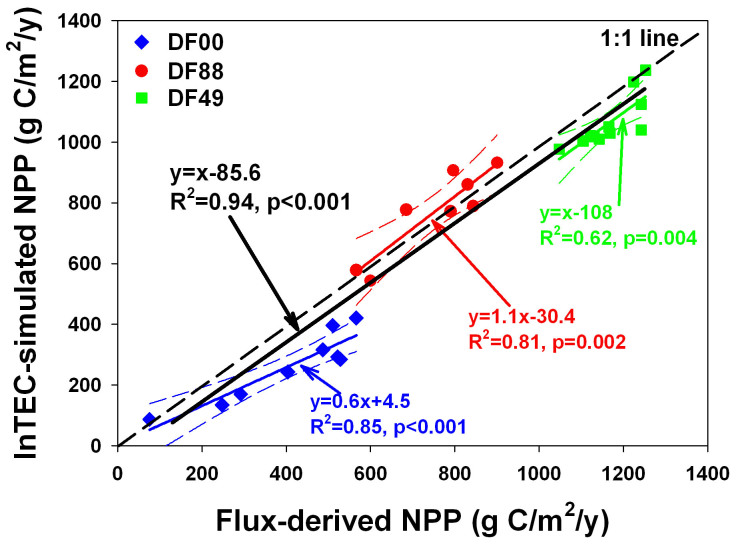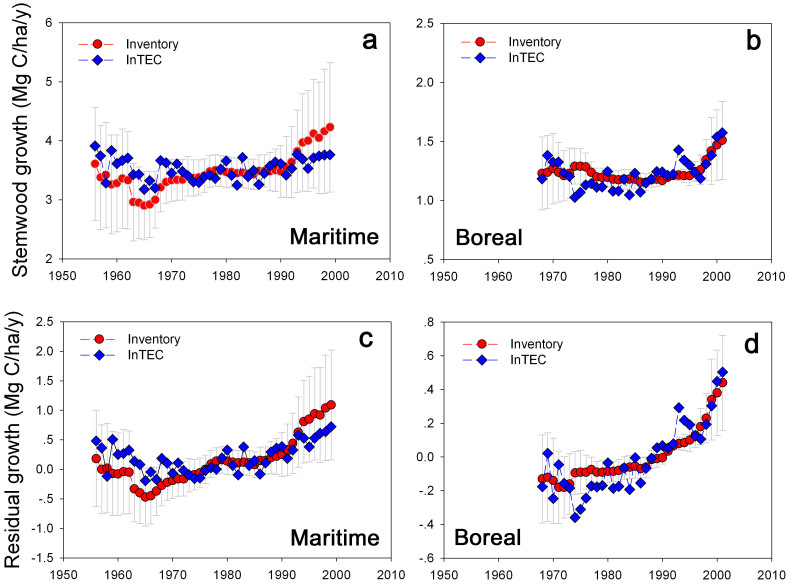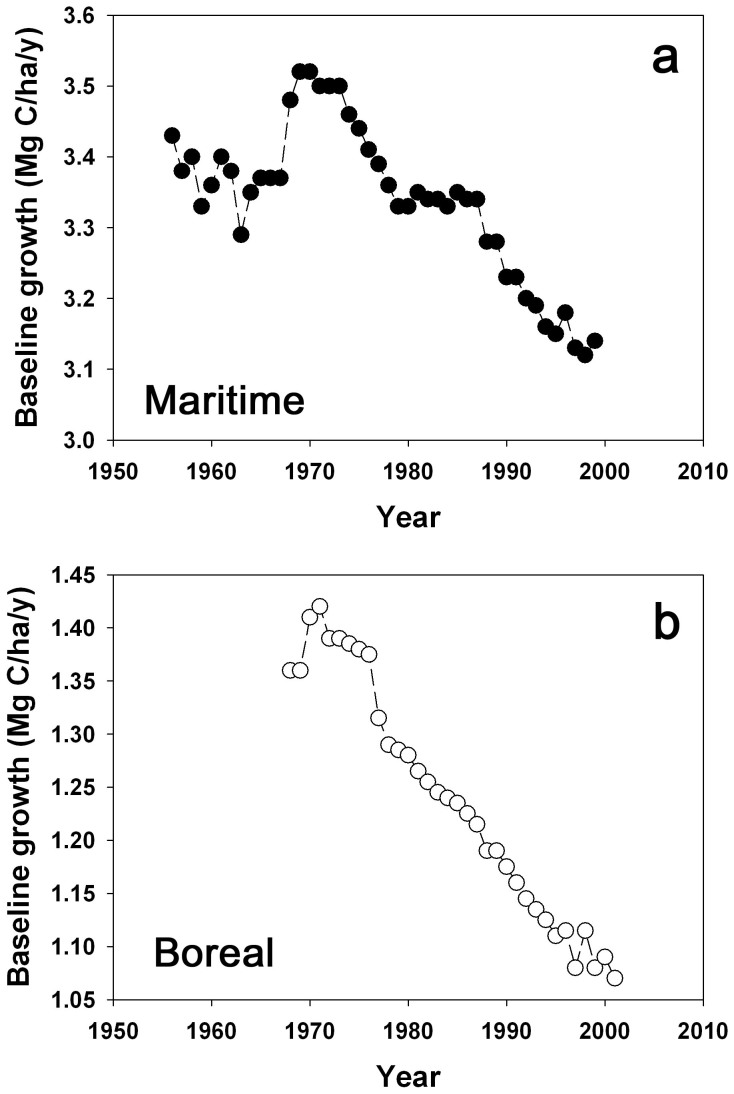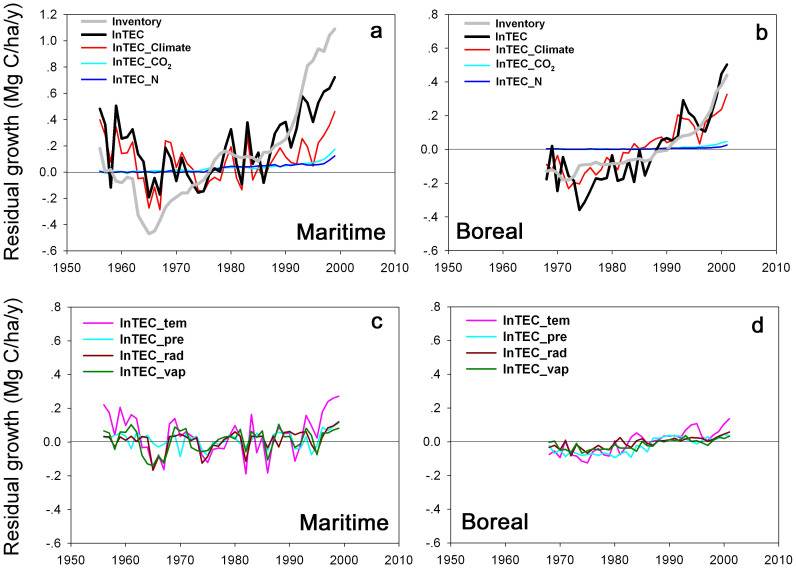Abstract
Changes in climate and atmospheric CO2 and nitrogen (N) over the last several decades have induced significant effects on forest carbon (C) cycling. However, contributions of individual factors are largely unknown because of the lack of long observational data and the undifferentiating between intrinsic factors and external forces in current ecosystem models. Using over four decades (1956–2001) of forest inventory data at 3432 permanent samples in maritime and boreal regions of British Columbia (B.C.), Canada, growth enhancements were reconstructed and partitioned into contributions of climate, CO2 and N after removal of age effects. We found that climate change contributed a particularly large amount (over 70%) of the accumulated growth enhancement, while the remaining was attributed to CO2 and N, respectively. We suggest that climate warming is contributing a widespread growth enhancement in B.C.'s forests, but ecosystem models should consider CO2 and N fertilization effects to fully explain inventory-based observations.
Forest ecosystems that sequester carbon (C) from the atmosphere play an important role in Earth's C budget by offsetting the increase in atmospheric carbon dioxide (CO2) caused by fossil fuel emissions and land-use change1. Net primary productivity (NPP) is strongly affected by many factors, including climate, atmospheric CO2 and nitrogen (N) deposition, making it a challenge to reconstruct long-term forest NPP responses to these factors2,3,4,5,6. The separation of NPP into impacts of climate change, CO2 and N is a prerequisite for future C accounting schemes that aim to establish a clear relationship between human activities and C uptake. Biogeochemical C cycle-climate models may be the best way to reconstruct long-term NPP as affected by environmental changes, projections of NPP responses to the changing future climate, and partition NPP variations into contributions from various factors7. Though these models have uncertainties, they present the most feasible way to achieve these objectives as short-term C cycle simulation would not be reliable for forests6. To reduce large uncertainties in model simulations, observational data with long enough duration must be used to constrain and refine models. The problem, however, is the unavailability of these data to determine whether an observed response of NPP would be sustained through time. A more fundamental problem in most current analyses, which has not been given sufficient attention or even overlooked, is our inability to differentiate NPP responses to variations in intrinsic factors (e.g., stand development) and external forces (e.g., global change). This differentiation is important because stand development plays a significant role on forest NPP. For example, a commonly observed pattern of decline in NPP with stand age in mature forests may have implications on the decreased NPP response to elevated CO28. A critical step, therefore, is to remove the effect of stand development on NPP before we proceed to determine the contributions of climate change, CO2 concentration and N deposition to NPP enhancement.
In this study, we first used an Integrated Terrestrial Ecosystem C-budget (InTEC) model which integrates stand age development with time to reproduce interannual variability of annual NPP at three chronosequences forest flux sites of British Columbia (B.C.), Canada. Then, InTEC model was recalibrated to reconstruct the long-term (1956–2001) stemwood growth enhancement (i.e., after removal effects of stand development from the absolute growth rates) revealed from repeated measurements at 3432 permanent inventory plots (PSPs) of forests in coastal (1966 plots) and interior (1466 plots) regions of B.C.. Contributions of climate, CO2 fertilization and N deposition on accumulated growth enhancements were then quantitatively determined by setting the factor in question constant in one simulation (e.g., CO2-based partition was estimated by detrending climate and nitrogen deposition used to drive the simulations). Our approach will provide useful guidance for future analyses of climate and atmospheric changes on global C sequestration.
Results
For three flux sites, the NPP values simulated using InTEC model agreed well with those derived from flux measurements, with coefficients of determination (R2) equal to 0.94 (p < 0.001) for the overall dataset and R2 of 0.85 (p < 0.001), 0.81 (p = 0.002) and 0.62 (p = 0.004) for DF00, DF88 and DF49, respectively (Fig. 1). Through this site level validation, we gained confidence that InTEC is a reliable model to link historical climate data with recent flux-tower observations in reproducing interannual variability of NPP across forests of various stand ages in B.C.
Figure 1. Relationships between flux-tower derived estimates of annual net primary productivity (NPP) and InTEC-simulated NPP for three chronosequences Douglas-fir stands in B.C.
DF00 ( ), DF88 (
), DF88 ( ) and DF49 (
) and DF49 ( ) represent flux sites of Douglas-fir stands harvested in 2000, 1988, and 1949, respectively. Solid and dash lines are the regression and 95% confidence levels for mean prediction, respectively.
) represent flux sites of Douglas-fir stands harvested in 2000, 1988, and 1949, respectively. Solid and dash lines are the regression and 95% confidence levels for mean prediction, respectively.
Age response function parameters for the InTEC simulations were recalibrated to match observations at PSPs (Supplementary Information). Inventory data suggested that stemwood growth (G_SW) of the coastal area showed a distinct pattern over the measurement period with a decrease during the middle 1960s and then recovered (~3.3 Mg C/ha/y) by the end of this decade (Fig. 2a). A gradual increase was observed since 1970 and G_SW reached 3.5 Mg C/ha/y at the beginning of 1990. In particular, a steep increase in G_SW was found for the next ten years with a value of 4.2 Mg C/ha/y for 1999, showing a rate of increase for this decade that was roughly seven times larger than that in the previous decades. The baseline stemwood growth (B_SW) generally exhibited a slow decrease over time, reflecting a small negative effect of stand aging on the stemwood growth due to the increase in average forest age of the population of PSPs (Fig. 3). The residual growth (R_SW, i.e., after removal effect of stand development) showed the same pattern as G_SW and a tremendous growth enhancement was observed for the last decade (Fig. 2c). The interior area went through a quite similar growth pattern but with a lower G_SW and R_SW than that in the coastal B.C. area.
Figure 2. Comparison of time series of InTEC simulations with observations from permanent inventory plots for maritime and boreal regions.
(a) and (b): stemwood growth simulation of InTEC ( ) and inventory data (
) and inventory data ( ) (R2 = 0.27, p < 0.001 and R2 = 0.39, p < 0.001 for maritime and boreal plots, respectively). (c) and (d): residual growth of InTEC (
) (R2 = 0.27, p < 0.001 and R2 = 0.39, p < 0.001 for maritime and boreal plots, respectively). (c) and (d): residual growth of InTEC ( ) and inventory data (
) and inventory data ( ) (R2 = 0.54, p < 0.001 and R2 = 0.77, p < 0.001 for maritime and boreal plots, respectively). Error bars indicate (±) stand deviations.
) (R2 = 0.54, p < 0.001 and R2 = 0.77, p < 0.001 for maritime and boreal plots, respectively). Error bars indicate (±) stand deviations.
Figure 3. Temporal changes of baseline stemwood growth of (a) maritime (1966 plots) and (b) boreal (1466 plots) regions from 1956 to 2001.
Simulations from the InTEC model generally followed the patterns of inventory observations for both regions. For the coastal area, the pronounced decrease of G_SW in middle 1960s was well captured. The main inconsistency for this region between the model and measurement occurred in the last decade when a rapid increase of G_SW was observed in the inventory data while InTEC-simulated increase was less rapid. However, if the effect of stand age was removed, this inconsistency can be mostly reduced, as illustrated in Fig. 4c with comparable slopes of growth enhancement curves between InTEC simulation and inventory data. For the interior region, model results were also consistent with the inventory data in terms of capturing the slight increase of G_SW in middle 1970s, the quick increase after middle 1990s, and the general pattern of R_SW for the whole measurement period.
Figure 4.
Partition of the growth enhancement observed from inventory into contributions from climate (Climate), CO2 fertilization (CO2) and nitrogen deposition (N) for the (a) maritime and (b) boreal regions. Partition of growth enhancement due to climate into contributions from temperature (tem), precipitation (pre), radiation (rad) and water vapor pressure (vap) for the (a) maritime and (b) boreal regions.
Based on these evaluations of InTEC with two different datasets, we then partitioned growth enhancement into contributions from different factors including climate, CO2 and N, and further separated the total climate effect into those from temperature, precipitation, radiation and water vapor pressure (Fig. 4). We found that climate was the dominating factor controlling on accumulated R_SW with 70.9% and 79.4% for coastal and interior regions, respectively with the remaining signal attributed to CO2 and N. In the coastal region, 18.7% of accumulated R_SW was attributed to CO2 and 12.8% for N. Similar results were observed for the interior region that CO2 and N contributed 15.8% and 6.9% to R_SW, respectively. Partitioning the climate effect into components due to temperature, precipitation, radiation and water vapor pressure suggested that temperature is the main factor (48.4% and 57.6% for coastal and interior regions, respectively). Contributions of other three factors differ by some extent between these two regions. For the coastal area, contributions for precipitation, radiation and water vapor pressure were 20.2%, 15.8% and 14.6%, respectively, while these values were 12.7%, 5.9% and 22.5% for the interior region.
Discussion
The most distinct feature of the InTEC model compared with other coupled C-climate models is its incorporation of the NPP-age relationship of forests, by which InTEC considers the structural changes associated with stand development through time. This feature gives InTEC a capacity to remove the influence of the age factor on stemwood growth, making it possible for the consequent analyses of the contributions from individual non-disturbance forcings. The removal of the age effect in this process is the necessary prerequisite since increasing evidence shows that stand age plays an important role in forest growth and neglecting the age effect may lead to incorrect responses of NPP or tree growth to other factors9,10. Results of our analysis also supported this theory that by removal of baseline growth resulted from stand ages, correlations of residual growth between simulations and observations were improved substantially for both regions.
Using over three thousand permanent sample plots over four decades, we observed a growth enhancement of forests in British Columbia, Canada. Contributions from climate change, CO2 and N deposition were factored out with a process-based model. Climate change has been demonstrated as the main contributor to the growth enhancement in both coastal and interior regions, explaining over 70% of the trend. This dominant role of climate change may indicate that global warming has markedly affected these high-latitude ecosystems. Such a pronounced impact of climate change on C dynamics is not unusual2,4,11. Our analysis further showed that the temperature is the most important factor of climate change in the high-latitudinal regions in B.C., and the underlying mechanism is the significantly increased growing season length (GSL) for two regions over the observation periods (Fig. S2).
CO2 and N generally contributed similar fractions (below 20%) to the overall growth enhancement (see Fig. S3 for data of CO2 and N) in the two regions studied here, yet they are also important to completely explain the growth enhancement. Direct comparison of the CO2 contribution with previous analyses might not be appropriate since the CO2 fertilization effect is reported to be not uniform through the various forest ecosystems and could vary with stand characteristics7,8,12,13,14. While there is no unique sensitivity of NPP to increasing CO2 concentration, the identification of its contribution is still important for regional C dynamics. The impact of N deposition would depend on whether the ecosystem is N limited and for how long it sustains. In N limited forest ecosystems, the likely effect of N deposition is the increased foliar N concentration with a positive effect on photosynthetic rates, which is observed for oceanic spruce stands11. Similar results were also observed by other studies showing enhanced production of leaves and wood in response to N deposition15. A simulation indicates that the N deposition generally increased NPP by 17% of US forests during last century12. Our simulations generally showed slightly lower (12.8% and 6.9% for coastal and interior regions, respectively) N contributions. However, these data still indicates that N contribution should be considered when explaining the growth enhancement in this region.
The contributions of both CO2 and N to growth enhancement were slightly higher in the coastal region than in the interior region. Mechanistic analyses of the differences in these contributions might be difficult at present, but a possible reason could be the interactions of these factors with water availability. The reason is that the effect of CO2 fertilization is balanced between NPP stimulated by increased CO2 and NPP decreased by potential drought. Therefore, even at elevated CO2, NPP may still decrease under severe drought so that the CO2 fertilization would be more evident in humid environments compared to arid or semi-arid regions16. The coastal region has more annual precipitation (1942 mm ± 174 mm) than the interior region (673 mm ± 64 mm) so that forests in this region endure little drought and can realize the full potential of the CO2 fertilization effect, while forests in the interior BC may experience periodic summer droughts that limit the duration of CO2 fertilization17. It should be noticed that the sum of contributions from all factors are not 100%, given that results from the portioning approach are approximately because of interactions of various factors and the nonlinear model descriptions. However, the interaction was low (within 2.5%), probably due to low values of these variables (high values tend to reach the saturation in sensitivity) and relatively short time duration of observation.
The NPP-age curve is the key component of the InTEC model and is consequently vital for the main conclusions of our analysis. Here we provide an additional discussion on this relationship to support our results of partition. Stand age is an important regulator of annual NPP, which increases at the initial several years of growth and maximizes at the mature age. After that, annual NPP generally shows a decrease trend and finally stabilizes in a certain level to maintain C neutral for old forests. The Douglas-fir stands of the Pacific Northwest are of high productivity (flux sites in this study) and annual NPP increases to around 1200 g C/m2 for DF49 which has an age of 65 (Figure 1). However, the PSPs used had an average age above 70 (Figure S1) and therefore, evidences should be provided to support the decreasing NPP response to an age above 70. For this purpose, we substantially reviewed the NPP-age response of forests. Previous analysis showed that annual NPP generally maximizes around an age of 35–60 for three chronosequences forests using ground measured data18. A later analysis also indicated that annual NPP would decrease after 40 years of growth for most North American forests19. Recently, a study further illustrated that the maximum annual NPP would be observed at an age around 55 for Canadian forests20, which agrees with results that shows the NPP of Douglas-fir stands of the Pacific Northwest generally enter into the decreasing trends above 7021. The currently most comprehensive analysis on NPP-age relationship of North American forests demonstrates that the timing of maximum annual NPP would fall in the range between 20–60 using forest inventory data covering more than 150,000 permanent field sample locations10. With these previous analyses on NPP-age relationships, in particularly those in Canada and Pacific Northwest regions, we suggest that our conclusions of partition based on NPP-age curve of InTEC would be reliable and acceptable.
With flux measurements and over four decades of inventory data, we partitioned stemwood growth enhancement of forest in B.C. into contributions of climate (temperature, precipitation, radiation, humidity) and atmospheric chemistry (CO2 concentration, nitrogen deposition) using the process-based InTEC model that considers stand development in simulating processes. Our results suggest that climate warming is contributing a widespread and significant growth enhancement in B.C.'s forests, but that inclusion of CO2 and N fertilization effects in the model are also necessary to fully explain the observed growth enhancement. Among the various climate factors, temperature was found to be the main factor inducing the growth enhancement in these high-latitude regions.
Methods
Flux data and permanent inventory plots
Two types of data were used in this study, including continuous flux measurements at three chronosequences forest sites in B.C. and 3432 permanent inventory plots (PSPs) of forests in coastal (1966 plots) and interior (1466 plots) regions of B.C. (Figure S1). Plots for these two regions belong to maritime and boreal ecozones, respectively. Detailed descriptions of the flux sites (Table S1) and PSPs were provided in Supplementary Information.
Data processing
Half-hourly ecosystem CO2 flux data were continuously measured at each site with the eddy-covariance technique22 and these data were obtained from Fluxnet-Canada archives (http://www.fluxnet-canada.ca). Detailed procedures for flux data processing (gap-filling and partition net ecosystem exchange (NEE) into gross primary productivity (GPP) and total ecosystem respiration (Re)) were provided in the Supplementary Information.
Repeated measurements of tree diameter and height between 1956 and 2001 were provided by the Inventory Branch of the BC Ministry of Forests, Lands and Natural Resource Operations and used to calculate stand-level stemwood biomass using allometric equations23,24. Mean annual stemwood biomass growth (G_SW) was then calculated over the five- or ten-year measurement intervals. The combined effect of intrinsic factors on tree growth, herein referred to as baseline stemwood growth (B_SW), was modeled by fitting Weibull distribution functions to the age response of observations for each type of dominant species25. The remaining (unexplained) variation of growth (R_SW) was then calculated by subtracting B_SW from G_SW. More specific descriptions on these inventory-based variables are provided in the Supplementary Information.
Integrated terrestrial ecosystem C-budget (InTEC) model and its inputs
The InTEC model is a process-based carbon cycle model18. Different datasets were used in the simulation of NPP at flux towers and PSPs (See Supplementary Information). To bridge NPP simulations and stemwood growth observations, we assumed that stemwood growth consists 31 percent of NPP for coniferous stands in InTEC simulations. The partition of stemwood growth enhancement into contributions from climate, CO2 and N factors was realized by setting the factor in question constant in one simulation26. Detailed introduction of the InTEC model and its inputs are provided in Supplementary Information.
Author Contributions
C.W., J.C., W.K. and D.P. designed this study. C.W. processed and analyzed InTEC model and flux data, and R.H. processed and analyzed inventory data. C.W. and J.C. wrote the first draft of the manuscript and C.B., A.G. and W.J. contributed to the writing and discussion of this study.
Supplementary Material
SR materials and methods
Acknowledgments
We appreciate scientists of flux sites for providing the data and the Inventory Branch of the Ministry of Forests, Lands and Natural Resource Operations for collection and access to Provincial forest inventories. This work was funded by an NSERC Strategic Grant (381474-09), the Major State Basic Research Development Program of China (2010CB950702) that supports the comparison of carbon uptakes between China and North America, and by the National Natural Science Foundation of China (41371013).
References
- Pan Y. et al. A Large and Persistent Carbon Sink in the World's Forests. Science 333, 988–993 (2011). [DOI] [PubMed] [Google Scholar]
- Myneni R. B. et al. Increased plant growth in the northern high latitudes from 1981 to 199. Nature 386, 698–702 (1997). [Google Scholar]
- Knapp A. K. et al. Rainfall variability, carbon cycling and plant species diversity in a mesic grassland. Science 298, 2202–2205 (2002). [DOI] [PubMed] [Google Scholar]
- Nemani R. R. et al. Climate-driven increases in global terrestrial net primary production from 1982 to 1999. Science 300, 1560–1563 (2003). [DOI] [PubMed] [Google Scholar]
- Magnani F. et al. The human footprint in the carbon cycle of temperate and boreal forests. Nature 447, 849–851 (2007). [DOI] [PubMed] [Google Scholar]
- Norby R. J. et al. CO2 enhancement of forest productivity constrained by limited nitrogen availability. Proc. Natl. Acad. Sci. USA 107, 19368–19373 (2010). [DOI] [PMC free article] [PubMed] [Google Scholar]
- Canadell J. G. et al. Factoring out natural and indirect human effects on terrestrial carbon sources and sinks. Environ. Sci. Policy 10, 370–384 (2007). [Google Scholar]
- Norby R. J. et al. Forest response to elevated CO2 is conserved across a broad range of productivity. Proc. Natl. Acad. Sci. USA 102, 18052–18056 (2005). [DOI] [PMC free article] [PubMed] [Google Scholar]
- Peñuelas J., Canadell J. G. & Ogaya R. Increased water-use efficiency during the 20th century did not translate into enhanced tree growth. Global Ecology Biogeo. 20, 597–608 (2011). [Google Scholar]
- He L. et al. Relationships between net primary productivity and forest stand age in U.S. forests. Global Biogeochem. Cycles 26, GB3009 (2012). [Google Scholar]
- Black T. A. et al. Increased carbon sequestration by a boreal deciduous forest in years with a warm spring. Geophys. Res. Lett. 27, 1271–1274 (2000). [Google Scholar]
- Pan Y. et al. Separating effects of changes in atmospheric composition, climate and land-use on carbon sequestration of U.S. mid-Atlantic temperate forests. For. Ecol. Manage. 259, 151–164 (2009). [Google Scholar]
- Keenan T. et al. Predicting the future of forests in the Mediterranean under climate change, with niche- and process-based models: CO2 matters!. Global Change Biol 17, 565–579 (2001). [Google Scholar]
- Piao S. et al. Effect of climate and CO2 changes on the greening of the Northern Hemisphere over the past two decades. Geophys. Res. Lett. 33, L23402 (2006). [Google Scholar]
- Oren R. et al. Soil fertility limits carbon sequestration by forest ecosystems in a CO2-enriched atmosphere. Nature 411, 469–472 (2001). [DOI] [PubMed] [Google Scholar]
- Morgan J. A. et al. Water relations in grassland and desert ecosystems exposed to elevated atmospheric CO2. Oecologia 140, 11–25 (2004). [DOI] [PubMed] [Google Scholar]
- Gerten D., Schaphoff S. & Lucht W. Potential future changes in water limitations of the terrestrial biosphere. Climatic Change 80, 277–299 (2007). [Google Scholar]
- Chen J. M. et al. Spatial distribution of carbon sources and sinks in Canada's forests. Tellus B 55, 622–641 (2003). [Google Scholar]
- Amiro B. D. et al. Ecosystem carbon dioxide fluxes after disturbance in forests of North America. J. Geophys. Res. 115, G00K02, 10.1029/2010JG001390 (2010). [Google Scholar]
- Coursolle C. et al. Influence of stand age on the magnitude and seasonality of carbon fluxes in Canadian forests. Agr. Forest Meteor. 165, 136–148 (2012). [Google Scholar]
- Williams C. A. et al. Carbon consequences of forest disturbance and recovery across the conterminous United States. Global Biogeochem. Cycles 26, GB1005, 10.1029/2010GB003947 (2012). [Google Scholar]
- Baldocchi D. D. Assessing the eddy covariance technique for evaluating carbon dioxide exchange rates of ecosystems: past, present and future. Global Change Biol. 9, 479–492 (2003). [Google Scholar]
- Lambert M. C., Ung C. H. & Raulier F. Canadian national tree aboveground biomass equations. Can. J. For. Res. 35, 1996–2018 (2005). [Google Scholar]
- Ung C., Bernier P. & Guo X. Canadian national biomass equations: new parameter estimates that include British Columbia data. Can. J. For. Res. 38, 1123–1132 (2008). [Google Scholar]
- Hember R. A. et al. Accelerating regrowth of temperate-maritime forests due to environmental change. Global Change Biol. 18, 2026–2040 (2012). [Google Scholar]
- Zhang F. et al. Attributing carbon changes in conterminous U.S. forests to disturbance and non-disturbance factors from 1901 to 2010. J. Geophys. Res. 117, G02021, 10.1029/2011JG001930 (2012). [Google Scholar]
Associated Data
This section collects any data citations, data availability statements, or supplementary materials included in this article.
Supplementary Materials
SR materials and methods






